Efficient Decoder for Turbo Product Codes Based on Quadratic Residue Codes
Abstract
1. Introduction
2. Background
2.1. Generator Polynomial of QR Codes
2.2. Decoding of QR Codes
| Algorithm 1: Chase-II algorithm with two terminating criteria |
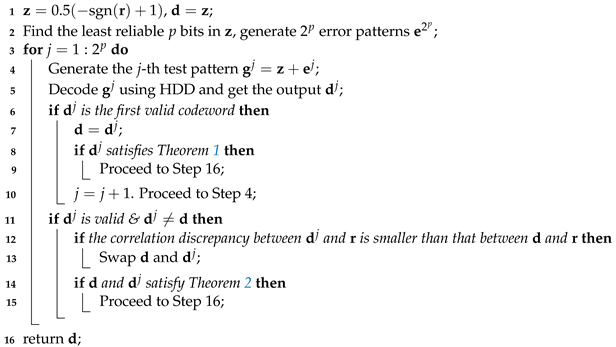 |
2.3. 2-D TPC
- 1.
- Place information bits in an array having rows and columns.
- 2.
- Encode the rows using Code .
- 3.
- Encode the columns using Code .
2.4. Pyndiah-Chase-II Algorithm
- 1.
- If (i) is an empty set or (ii) all codewords in have their i-th elements the same as , i.e., , thenwhere .
- 2.
- If one or more codewords in have their i-th elements different from , i.e., , we compute the squared Euclidean distance between each of these codewords and . In other words, we compute where . Then we select the codeword that is closest to in terms of squared Euclidean distance. Subsequently, is calculated usingwhere .
3. Proposed QR-TPC and Decoders
3.1. Proposed Scaling Vector
3.2. Proposed QR-TPC Decoder
| Algorithm 2: Proposed QR-TPC Decoding Algorithm |
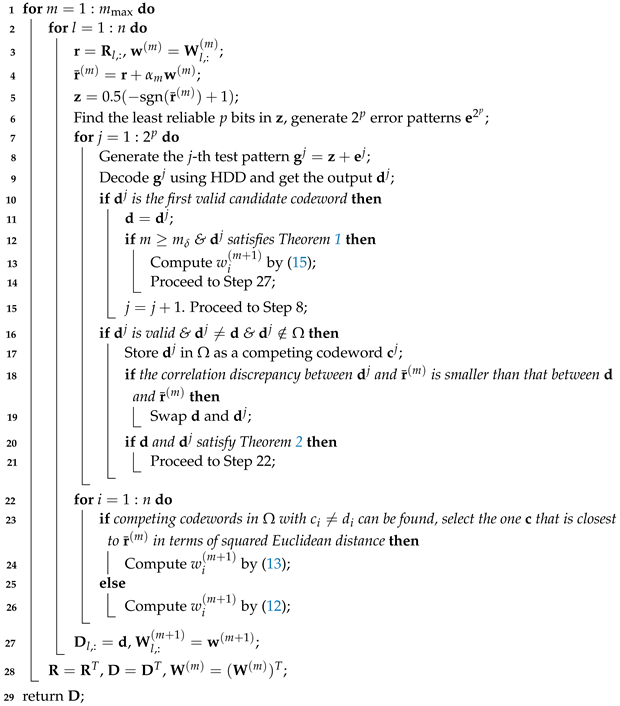 |
- 1.
- When Theorem 1 is satisfied, is the only output codeword from the decoder and is an empty set in Figure 2. One simple way to compute the extrinsic information is to apply (12) because is an empty set. However, as will be shown in Section 4, the error performance will be degraded quite significantly (particularly for short codes) compared with that of the original algorithm. We conjecture that the weights used in (12), i.e., ’s, are not large enough to correct the sign of an incorrect bit. Thus, we propose to use in (14) to replace in computing . In other words, when Theorem 1 is applied and is satisfied, we compute usingMoreover, we set a threshold half-iteration number , which defines the occasion that Theorem 1 starts being applied to the Chase-II decoder. The rationale of setting such a threshold is as follows. During the first few half-iterations, the inputs to the Chase-II decoder, i.e., , may not have very high reliabilities. Thus, the ML codeword output is not likely to be the transmitted component codeword. If we apply Theorem 1 and (15) to compute the extrinsic information now, the extrinsic information may not be accurate. But after a number of half-iterations, should become much more reliable and the ML codeword output is more likely to be the transmitted component codeword. Using Theorem 1 and (15) to compute the extrinsic information therefore becomes more accurate. Based on the above rationale, Theorem 1 will be applied when (refer to Line 12 to Line 14 of in Algorithm 2). Moreover, the first entries in will not be used in the Chase-II decoder when .
- 2.
4. Simulation Results
4.1. BER Performance Comparison
- Threshold : For certain QR-TPCs, the threshold provides a trade-off between BER performance and computational complexity. It can be seen that increasing from 1 to 4 can further improve the BER performance of our proposed algorithm for the QR-TPC.
- Overall BER performance: We can see that no significant BER deviation between the proposed algorithm and the algorithm in [4]. To be more specific, Figure 4 shows that there are slight BER performance gaps compared with that of the algorithm in [4] for the QR-TPC and QR-TPC. Nonetheless, the BER performance loss is tolerable. Furthermore, the proposed algorithm provides better performance with significant computational complexity reduction for the QR-TPC and QR-TPC. As a result, the proposed algorithm has a similar BER performance as the algorithm in [4].
4.2. Complexity Comparison
- Proposed scaling vector: When , we can observe that our proposed algorithm can always avoid more HDD operations when using (15) instead of (12) to compute the extrinsic information. For instance, when dB, the average number of HDD operations for the QR-TPC, QR-TPC, QR-TPC and QR-TPC are reduced more by approximately , , and , respectively, using (15) instead of (12).
- Threshold : Using compared with using further reduces the average number of HDD operations because Theorems 1 and 2 are applied earlier (i.e., starting the first half-iteration) in the modified Chase-II decoder.
- The reduction in the average number of HDD operations increases as : In the low region, the number of error bits that occur in each codeword is more likely to exceed the error-correction capability t of the QR code. Thus a valid codeword that satisfies Theorem 1 or Theorem 2 cannot be found easily. As increases, the ML codeword can be obtained more readily found using Theorem 1 or Theorem 2 and hence the modified Chase-II decoder can terminate earlier. We take and dB as an example. For the QR-TPC, QR-TPC, QR-TPC and QR-TPC, the average numbers of HDD operations used in our proposed algorithm are reduced by , , and , respectively, compared with those used in the algorithm in [4]; when is increased to dB, the numbers of HDD operations are reduced by , , and , respectively.
4.3. Comparison with 5G LPDC Codes
5. Conclusions
Author Contributions
Funding
Conflicts of Interest
References
- Elias, P. Error-free coding. Trans. IRE Prof. Group Inf. Theory 1954, 4, 29–37. [Google Scholar] [CrossRef]
- Berrou, C.; Glavieux, A. Near optimum error correcting coding and decoding: Turbo-codes. IEEE Trans. Commun. 1996, 44, 1261–1271. [Google Scholar] [CrossRef]
- Pyndiah, R.; Glavieux, A.; Picart, A.; Jacq, S. Near optimum decoding of product codes. In Proceedings of the 1994 IEEE GLOBECOM. Communications: The Global Bridge, San Francisco, CA, USA, 28 Novermber–2 December 1994; Volume 1, pp. 339–343. [Google Scholar] [CrossRef]
- Pyndiah, R. Near-optimum decoding of product codes: Block turbo codes. IEEE Trans. Commun. 1998, 46, 1003–1010. [Google Scholar] [CrossRef]
- Prange, E. Some Cyclic Error-Correcting Codes with Simple Decoding Algorithms; Technical Report TN-58-156; Air Force Cambridge Res. Center: Cambridge, MA, USA, 1958. [Google Scholar]
- Honary, B.; Hunt, B.; Maundrell, M. Improving automatic link establishment through a new soft decision trellis decoder for the (24,12) Golay code. In Proceedings of the Sixth International Conference on HF Radio Systems and Techniques, York, UK, 4–7 July 1994; pp. 182–185. [Google Scholar] [CrossRef]
- Argon, C.; McLaughlin, S.W. An efficient chase decoder for turbo product codes. IEEE Trans. Commun. 2004, 52, 896–898. [Google Scholar] [CrossRef]
- Al-Dweik, A.; Goff, S.; Sharif, B. A Hybrid Decoder for Block Turbo Codes. IEEE Trans. Commun. 2009, 57, 1229–1232. [Google Scholar] [CrossRef]
- Lu, P.; Lu, E.; Chen, T. An efficient hybrid decoder for block turbo codes. IEEE Commun. Lett. 2014, 18, 2077–2080. [Google Scholar] [CrossRef]
- Ahn, B.; Yoon, S.; Heo, J. Low Complexity Syndrome-Based Decoding Algorithm Applied to Block Turbo Codes. IEEE Access 2018, 6, 26693–26706. [Google Scholar] [CrossRef]
- Yoon, S.; Ahn, B.; Heo, J. An advanced low-complexity decoding algorithm for turbo product codes based on the syndrome. Eurasip J. Wirel. Commun. Netw. 2020, 2020, 1–31. [Google Scholar] [CrossRef]
- Son, J.; Kong, J.J.; Yang, K. Efficient decoding of block turbo codes. J. Commun. Netw. 2018, 20, 345–353. [Google Scholar] [CrossRef]
- Wang, Y.; Lin, J.; Wang, Z. A low-complexity decoder for turbo product codes based on extended hamming codes. In Proceedings of the 2018 IEEE 18th International Conference on Communication Technology (ICCT), Chongqing, China, 8–11 October 2018; pp. 99–103. [Google Scholar] [CrossRef]
- Kishore, J.H.; Yamuna, B.; Balasubramanian, K. Design of a Fast Chase Algorithm based High Speed Turbo Product Code Decoder. In Proceedings of the 2021 International Conference on Advances in Computing and Communications (ICACC), Kochi, India, 21–23 October 2021; pp. 1–5. [Google Scholar] [CrossRef]
- Askali, M.; Ayoub, F.; Chana, I.; Belkasmi, M. Iterative soft permutation decoding of product codes. Comput. Inf. Sci. 2016, 9, 128–135. [Google Scholar] [CrossRef]
- Le, N.; Soleymani, A.R.; Shayan, Y.R. Distance-based-decoding of block turbo codes. IEEE Commun. Lett. 2005, 9, 1006–1008. [Google Scholar] [CrossRef]
- Taipale, D.J.; Pursley, M.B. An improvement to generalized-minimum-distance decoding. IEEE Trans. Inf. Theory 1991, 37, 167–172. [Google Scholar] [CrossRef]
- Wang, L.; Li, Y.; Truong, T.K.; Lin, T. On decoding of the (89, 45, 17) quadratic residue code. IEEE Trans. Commun. 2013, 61, 832–841. [Google Scholar] [CrossRef]
- Chase, D. A class of algorithms for decoding block codes with channel measurement information. IEEE Trans. Inf. Theory 1972, 18, 170–182. [Google Scholar] [CrossRef]
- Li, Y.; Duan, Y.; Chang, H.C.; Liu, H.; Truong, T.K. Using the difference of syndromes to decode quadratic residue codes. IEEE Trans. Inf. Theory 2018, 64, 5179–5190. [Google Scholar] [CrossRef]
- Duan, Y.; Li, Y. An Improved Decoding Algorithm to Decode Quadratic Residue Codes Based on the Difference of Syndromes. IEEE Trans. Inf. Theory 2020, 66, 5995–6000. [Google Scholar] [CrossRef]
- Dave, S.; Kim, J.; Kwatra, S.C. An efficient decoding algorithm for block turbo codes. IEEE Trans. Commun. 2001, 49, 41–46. [Google Scholar] [CrossRef]
- Kaneko, T.; Nishijima, T.; Inazumi, H.; Hirasawa, S. An efficient maximum-likelihood-decoding algorithm for linear block codes with algebraic decoder. IEEE Trans. Inf. Theory 1994, 40, 320–327. [Google Scholar] [CrossRef]
- Chairman, S. Chairman’s Notes of Agenda Item 7.1.5 Channel Coding and Modulation. In Proceedings of the TSG RAN WGI Meeting 87, R1-1613710, 3GPP Session Chairman (Nokia), Reno, Nevada, USA, 14–18 November 2016. [Google Scholar]
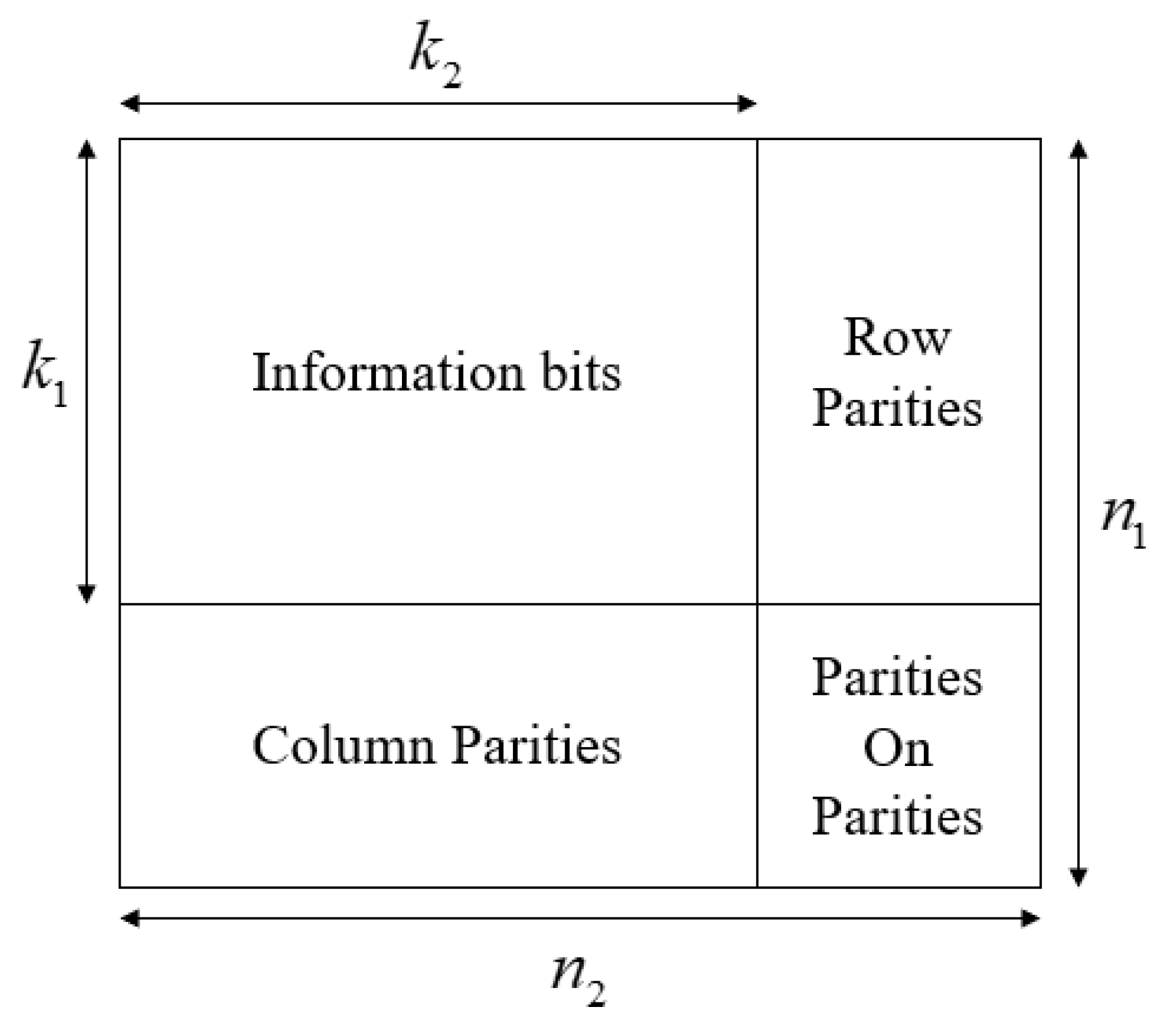


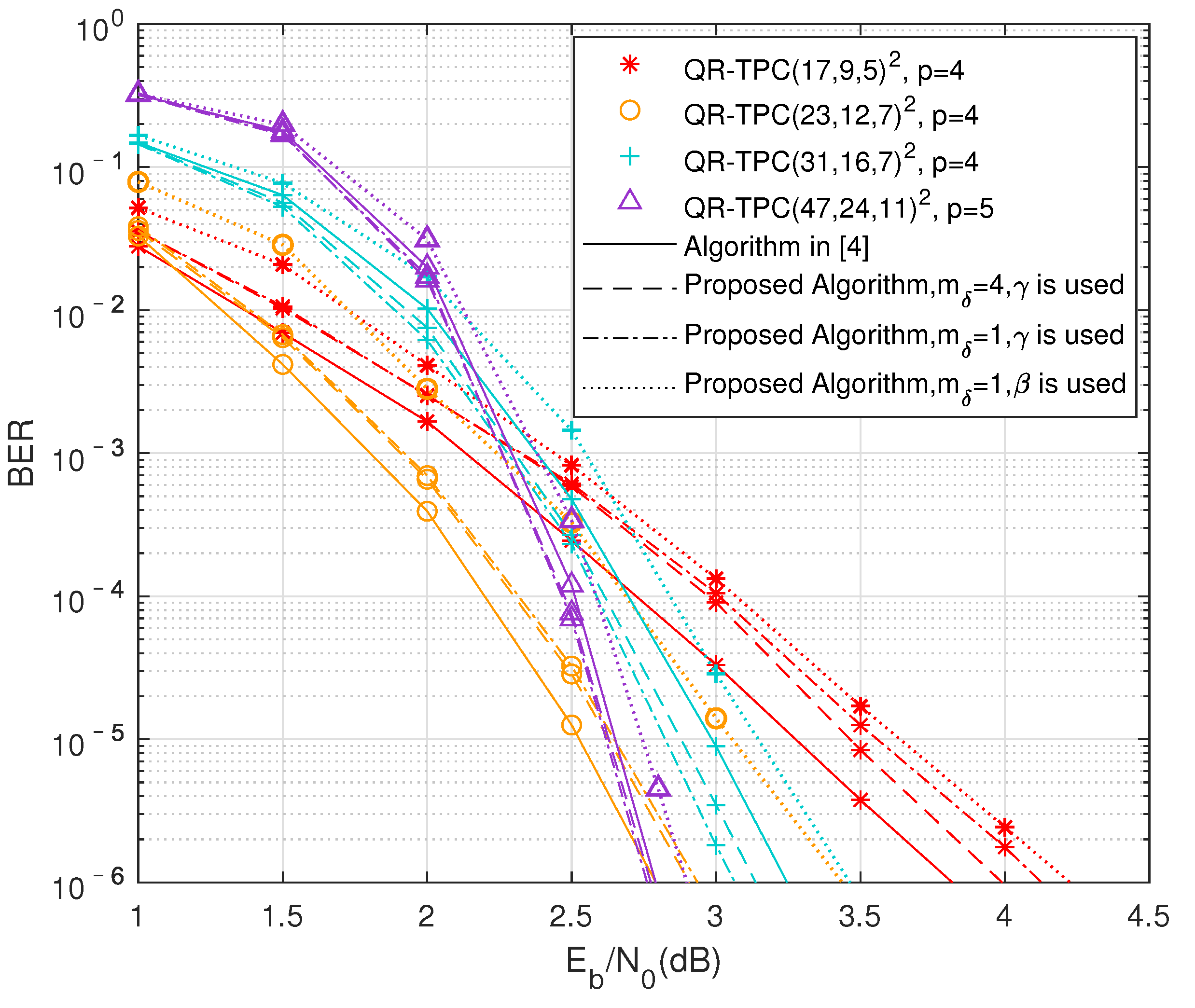
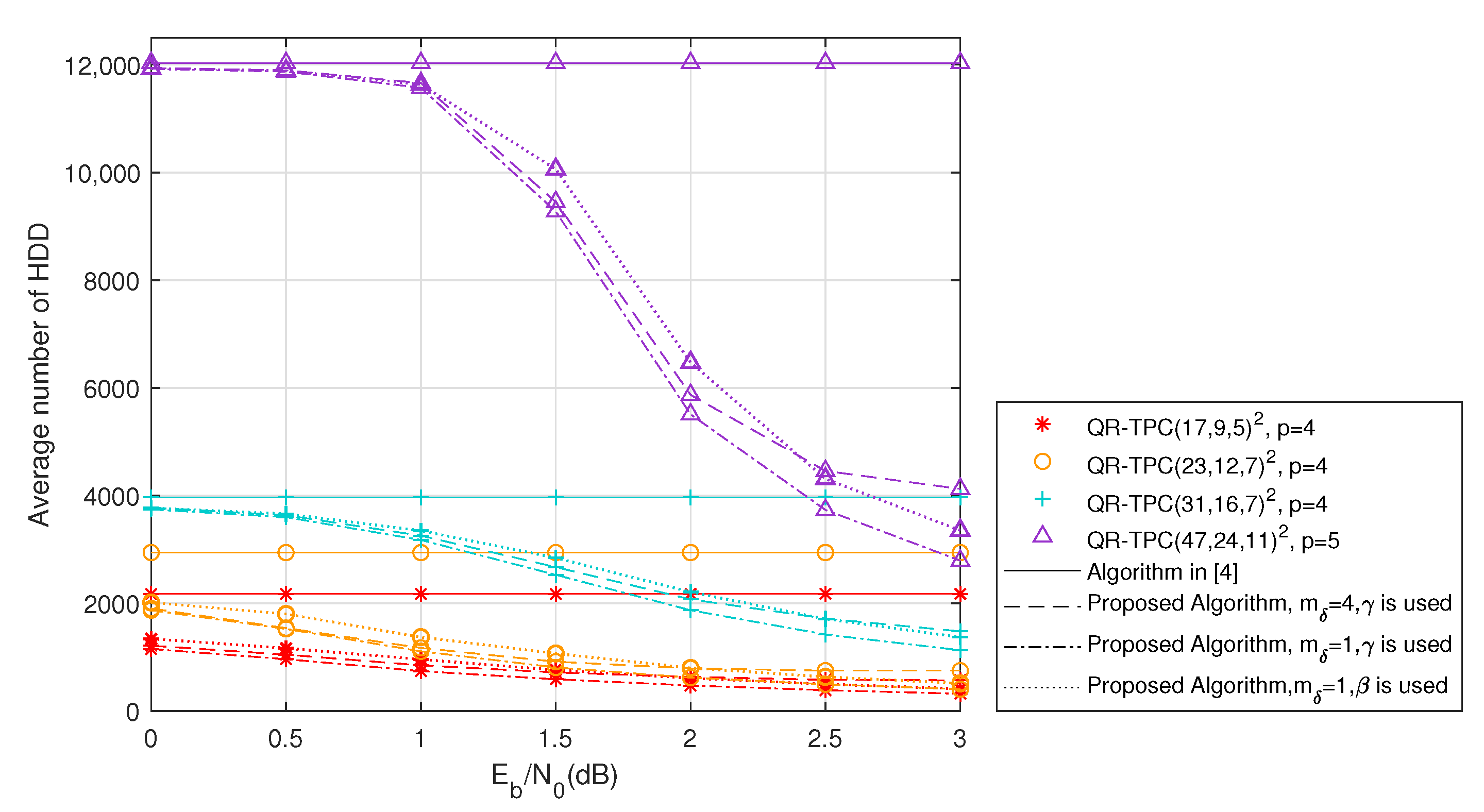
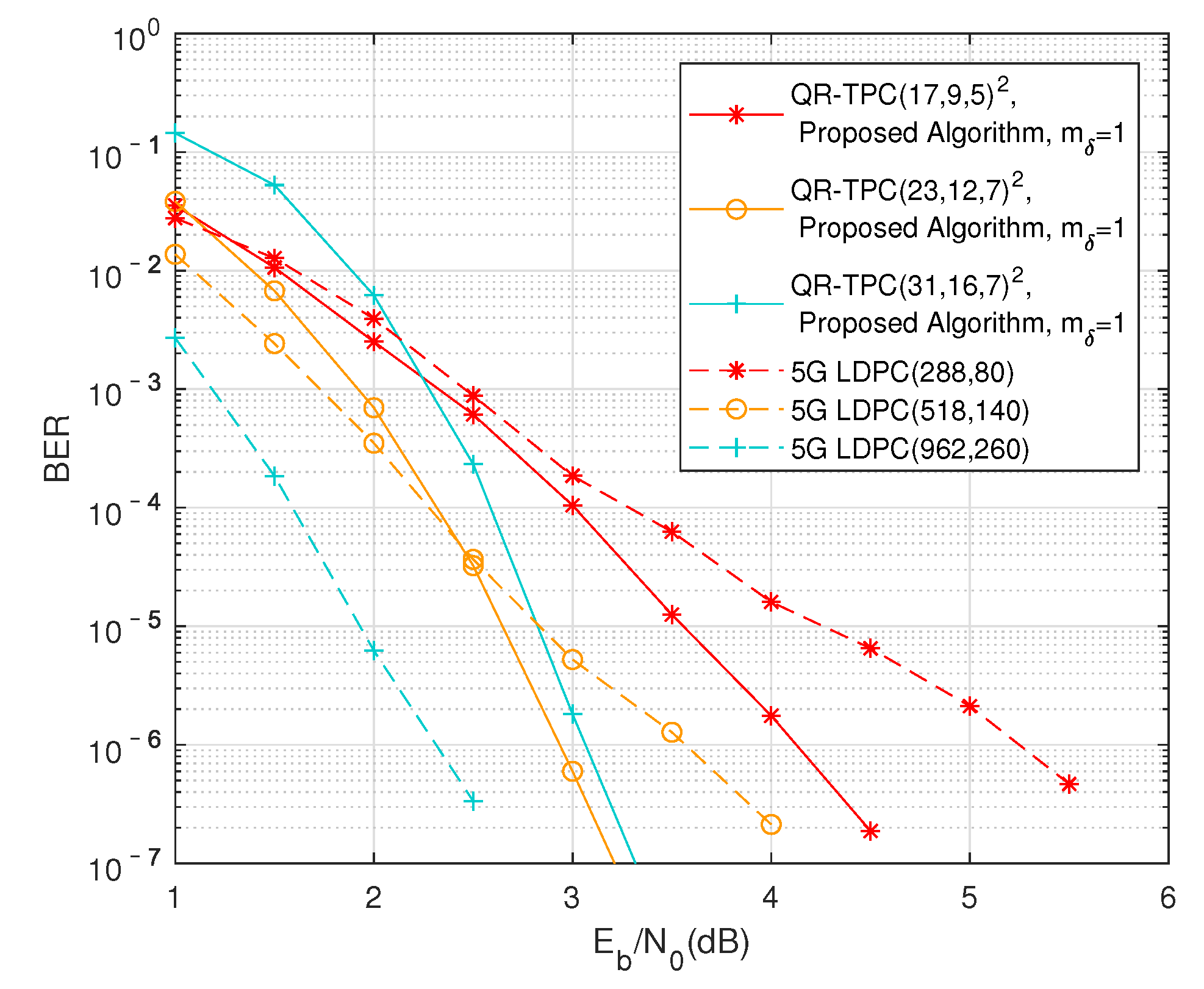
| QR-TPC | Codeword Length | Information Length | Code Rate |
|---|---|---|---|
| 289 | 81 | 0.280 | |
| 529 | 144 | 0.272 | |
| 961 | 256 | 0.266 | |
| 2209 | 576 | 0.261 |
| Operation | The Proposed Algorithm | Algorithm in [15] | ||
|---|---|---|---|---|
| Complexity Comparison | Relative Number | Complexity Comparison | Relative Number | |
| GF(+) | 2,011,200 | 17,672,000 | ||
| GF(≪) | 80,448 | 8,648,000 | ||
| R(+) | 23,205,896 | 17,672,000 | ||
| R(*) | 17,672 | 17,672,000 | ||
| Size of BG2 | Lifting Size | Codeword Length | Information Length | Code Rate |
|---|---|---|---|---|
| 26 × 36 | 8 | 288 | 80 | 0.278 |
| 27 × 37 | 14 | 518 | 140 | 0.270 |
| 27 × 37 | 26 | 962 | 260 | 0.270 |
Publisher’s Note: MDPI stays neutral with regard to jurisdictional claims in published maps and institutional affiliations. |
© 2022 by the authors. Licensee MDPI, Basel, Switzerland. This article is an open access article distributed under the terms and conditions of the Creative Commons Attribution (CC BY) license (https://creativecommons.org/licenses/by/4.0/).
Share and Cite
Dong, J.; Li, Y.; Liu, R.; Guo, T.; Lau, F.C.M. Efficient Decoder for Turbo Product Codes Based on Quadratic Residue Codes. Electronics 2022, 11, 3598. https://doi.org/10.3390/electronics11213598
Dong J, Li Y, Liu R, Guo T, Lau FCM. Efficient Decoder for Turbo Product Codes Based on Quadratic Residue Codes. Electronics. 2022; 11(21):3598. https://doi.org/10.3390/electronics11213598
Chicago/Turabian StyleDong, Jie, Yong Li, Rui Liu, Taolin Guo, and Francis C. M. Lau. 2022. "Efficient Decoder for Turbo Product Codes Based on Quadratic Residue Codes" Electronics 11, no. 21: 3598. https://doi.org/10.3390/electronics11213598
APA StyleDong, J., Li, Y., Liu, R., Guo, T., & Lau, F. C. M. (2022). Efficient Decoder for Turbo Product Codes Based on Quadratic Residue Codes. Electronics, 11(21), 3598. https://doi.org/10.3390/electronics11213598






